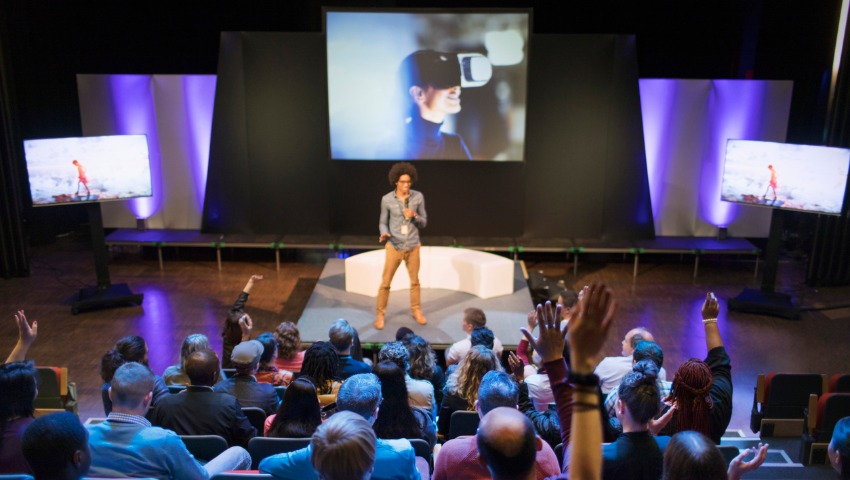Did you multitask in your meetings yesterday? Yeah, I figured as much. Imagine what your virtual event attendees are doing. If you’re standing in front of an audience, chances are you know some tricks to keep them engaged. You might pace around the room, use gestures, note who looks bored and ask them a question. Any number of things can bring attendee attention back to you in a live setting. But virtual events—webinars, meetings or hybrid conferences—leave you flying blind.
After producing thousands of presentations for virtual and live events, we’ve come up with three tried-and-true ways to make your next one a success.
Captivate Through Control
In a webinar or virtual meeting, your mission is to control attendee focus, so they don’t read ahead and then pop over to their email. You need to be deliberate about how you design your slides to keep them engaged.
While it seems a little counterintuitive, you need a lot of slides. Where in a typical meeting where you can pause on a slide for a while, you need to fly through slides every few seconds to keep your audience’s attention in the virtual world. Break apart your slides so there is only a snippet or two of information on each and keep them moving to sustain attendee eyes on the screen.
Use powerful visuals and elegant—not cheesy—animations to take the place of too much text. And don’t fall into a rut with every slide looking the same. You can still stay on brand while introducing variety by using a full-screen image or a solid-color slide with a few pithy words rather than repurposing the same old text template, slide after slide.
Your replacement for gestures? Vocal variety. Get loud; get soft. Vary your pitch from high to low, and your speed from fast to slow. Every now and again, pause—but not for too long.
Another great trick is to use anticipation. Say an attendee is looking at another screen like their phone, but is still listening. If you say: “as you can see right here” or “as I’m about to show you,” but don’t say exactly what’s on the slide. That way they may wonder what you’re showing and come back.
Use Platform Engagement Tools
Every webinar platform has tools designed to engage audiences, but they’re rarely used. You can set yourself apart by simply becoming familiar with the tools at your disposal. The simplest to use are highlighters, drawing tools for circling key points or moving your cursor to point at elements on your slides.
Polls are easy to set up in advance of your presentation. Just think of a few questions that would yield interesting results, prove your point or give you data to use for future needs. Take a few minutes to prepare answers for each of the possible outcomes and rehearse them, so you’re ready to handle whatever the queries might be.
According to Malcolm Lotzof, business technology strategist at Intrado Digital Media, “If the purpose of your presentation is to generate leads, you could use a tool like ours to deliver a call to action through a poll asking the viewers if they would like someone to contact them within 24 hours, 7 days, 30 days or never.”
And don’t wait to deliver your call to action until the end of your session when people are dropping off or preparing for their next meeting. Lotzof continues, “The key is to place the call to action in the presentation where an emotion is being elicited. The emotion drives the response, the response drives the call to action and the call to action drives results.”
Then, there’s video. Don’t just turn it on and leave it going. Use it strategically. Turn it on at your intro while establishing a connection, then off for a while when talking about complex information that the participant needs to process, and then back on when you’re making an emotional point. And be sure to end with it on. If your collaboration platform supports multiple videos, then start the webinar with you and your co-presenter on live video. If the platform supports pre-recorded video, use that in your webinar when appropriate to reengage your audience. Follow with your call-to-action poll, and you’ve created a dramatically different experience.
Prepare, Prepare, Prepare
Part of the problem with boring webinars is that best practices have died off. “Presenters—especially internal presenters—tend to wait until the last minute to prepare their decks,” says Lori Bush Shepard, a strategic marketing consultant and former corporate marketing vice president at Marketo and Clarizen. “They scramble to bolt together what I like to call a ‘Franken-deck’ of slides from other presentations. There’s often no cohesive story. You really need to take a step back, think of what message you want your attendees to get from the presentation and then structure a well-organized session to make sure they get it.”
What’s in this for your co-presenters? Are they product marketers desperate for leads? Are they looking to raise their status in the organization? Arm them with arguments for how being creative and being ready ahead of time can help them achieve their goals.
In Short, Everything Has to be Better
Don’t let your virtual events be a virtual disaster. Use creative and bold slide design, your platform’s engagement tools, video and a streamlined message to prevent a waste of effort. Bottom line: only engaged attendees convert.
Danielle Daly Sabaris is co-founder and CEO of Slidetown, a company committed to telling powerful stories with stunning presentation slides. She has over a decade of experience improving the quality of presentations in the business world and has produced some 10,000 impactful presentations for organizations of all sizes in a broad array of market segments.




